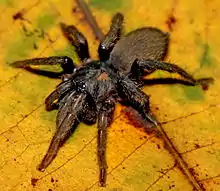| Neoheterophrictus | |
|---|---|
 | |
| Female Neoheterophrictus smithi | |
| Scientific classification | |
| Domain: | Eukaryota |
| Kingdom: | Animalia |
| Phylum: | Arthropoda |
| Subphylum: | Chelicerata |
| Class: | Arachnida |
| Order: | Araneae |
| Infraorder: | Mygalomorphae |
| Family: | Theraphosidae |
| Genus: | Neoheterophrictus Siliwal & Raven, 2012[1] |
| Type species | |
| Neoheterophrictus crurofulvus Siliwal, Gupta & Raven, 2012[1] | |
| Species | |
|
See text. | |
Neoheterophrictus is a genus of tarantula in the family Theraphosidae. It comprises 8 species, all found in India.[2]
Characteristics
Neoheterophrictus is similar to Heterophrictus and Plesiophrictus, however the females differ by having a different spermathecae structure, which have two receptacles with many lobes/termini at the end. Males are distinguished from Plesiophrictus by the absence of a tegular keel on the male palpal bulb. It occurs in the Western Ghats, India.[3]
Etymology
The name is a combination of two words neo and heterophrictus, neo in Latin meaning "new" and Heterophrictus being a genus name within the family Theraphosidae.[3][2]
Species
As of January 2022, the World Spider Catalog recognized 8 species. All are restricted to India.[1]
- Neoheterophrictus amboli Mirza & Sanap, 2014 - India
- Neoheterophrictus bhori (Gravely, 1915) - India
- Neoheterophrictus chimminiensis Sunil Jose, 2020 - India
- Neoheterophrictus crurofulvus Siliwal, Gupta & Raven, 2012 (type) - India
- Neoheterophrictus madraspatanus (Gravely, 1935) - India
- Neoheterophrictus sahyadri Siliwal, Gupta & Raven, 2012 - India
- Neoheterophrictus smithi Mirza, Bhosale & Sanap, 2014 - India
- Neoheterophrictus uttarakannada Siliwal, Gupta & Raven, 2012 - India
References
- 1 2 3 "Gen. Neoheterophrictus Siliwal & Raven, 2012", World Spider Catalog, Natural History Museum Bern, retrieved 2015-12-10
- 1 2 "Neoheterophrictus". Tarantupedia.
- 1 2 Siliwal, M.; N. Gupta; R. Raven (2012). "A new genus of the family Theraphosidae (Araneae: Mygalomorphae) with description of three new species from the Western Ghats of Karnataka, India". Journal of Threatened Taxa. 4 (14): 3233–3254. doi:10.11609/jott.o3065.3233-54.
This article is issued from Wikipedia. The text is licensed under Creative Commons - Attribution - Sharealike. Additional terms may apply for the media files.